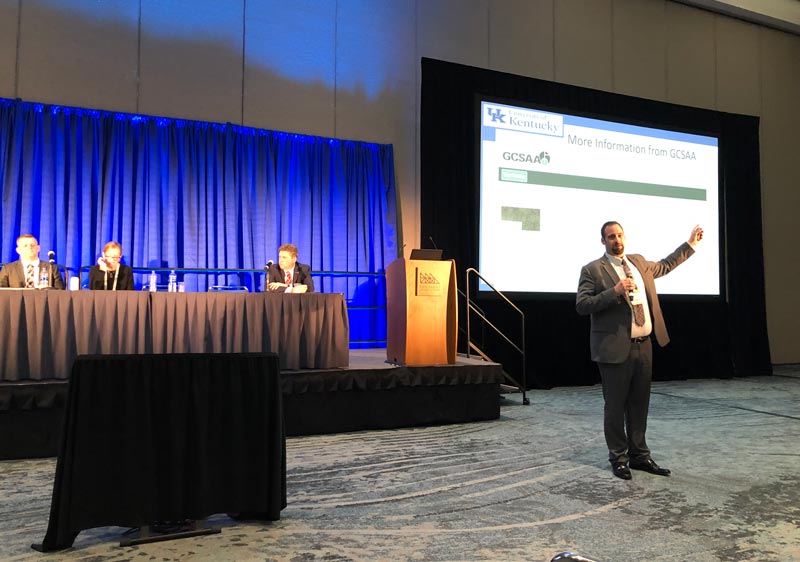
Ken Cropper, Ph.D., from the University of Kentucky, speaks to the “Turf Solutions I” crowd Feb. 4 about a formidable foe for superintendents: moss on greens. Photo by Roger Billings
Turfgrass is the superintendent’s baby, the No. 1 concern at any golf course. A trio of experts from academia and an accomplished superintendent discussed turf problems and how to address them in “Turf Solutions I” on Monday at the 2019 Golf Industry Show in San Diego. The education session was chaired by Mike Richardson, Ph.D., from the University of Arkansas.
Beth Guertal, Ph.D., from Auburn University, opened the session with a discussion of silicon, how plants use it and whether it provides any benefits for turfgrass. Silicon is not an essential element — that is, plants can survive without it, but it has been officially recognized as an element that is beneficial for some plants. Various studies have found that silicon may help with disease suppression, reduce the effects of wear and increase blade stiffness, but results have not been consistent.
Silicon is an abundant element, is present in the soil and is taken up naturally by plants. Superintendents interested in applying silicon should examine the labels of products that purportedly contain silicon (or silica). The ideal rate for most turf is 18 pounds/1,000 square feet, but the percentage found in fertilizers is often quite small (less than 1%), requiring a significant application of product.
Jason Haines, superintendent at Sunshine Coast Golf & Country Club in Roberts Creek, British Columbia, and Bill Kreuser, Ph.D., from the University of Nebraska-Lincoln, gave superintendents a driving lesson. The pair think superintendents should learn how to “drive the growth rate” of their courses, which means knowing when to speed up (add nitrogen) and when to put on the brakes (reduce the nitrogen or even add PGRs).
Haines has instituted some perhaps novel practices at his course to reduce inputs, cut costs and produce better playing conditions. He advocates measuring clippings to determine whether the grass is going too fast, and he has developed a Sand-O-Meter to gauge topdressing use. (Read more about Haines’ methods and the Sand-O-Meter.) Kreuser advised cautious use of PGRs to slow growth.
The final presentation was about moss, a problem so persistent that superintendents have used everything they can think of (baking soda, iron sulfate, Dawn dishwashing liquid) to eradicate it — and failed. Ken Cropper, Ph.D., from the University of Kentucky, suggested avoiding liquid fertilizers, reducing irrigation frequency, improving drainage and reducing shade. Increasing mowing height may also be helpful.
Cropper mentioned that recent studies by Zane Raudenbush, Ph.D., and University of Nebraska-Lincoln have explored the effects on moss of cultural practices such as verticutting, aerification and topdressing. The results of Raudenbush’s research were published in the February 2019 issue of GCM.
Teresa Carson is GCM’s science editor.